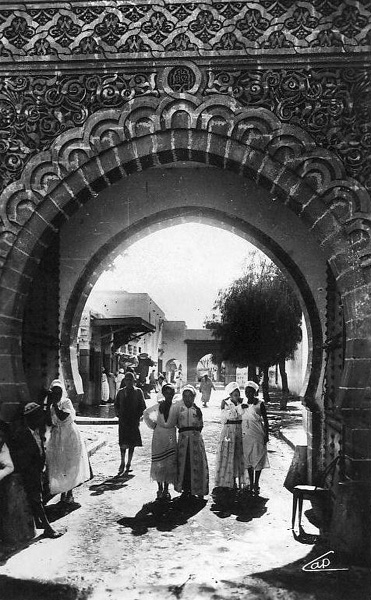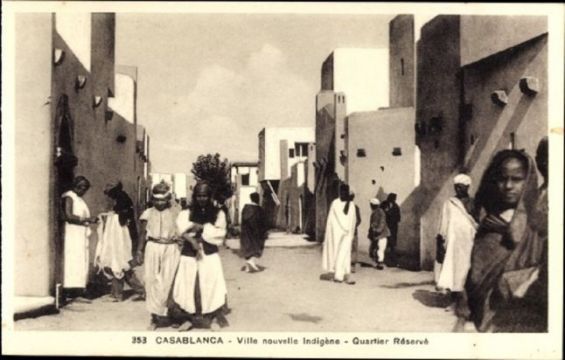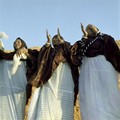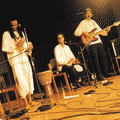An unusual theme park in Casablanca, where sex workers offered erotic and exotic shows to tourists and visitors, Bousbir, the city established by the French to legitimize prostitution. The fantasy quarter located in the outskirts of the old Medina, combined a significant trinity linking, Colonialism to tourism and sexuality.
The Moroccan Red-light was nothing like one would expect it, a refuge for tourists who came to visit the brothels but also to eat in its restaurants, attend its cabarets, cafés, and boutiques. Constructed by the French in 1924, Bousbir was indeed a touristic attraction during the colonial period. The nature of the quarter was thoroughly studied by Jean-Francois Staszak, a researcher specialized in gender and postcolonial studies, in his article «Colonial tourism and prostitution : the visit to Bousbir in Casabanca (1924-1955)», he described it as a «prison and theme park».
 Young women at the Bousbir quarter./Ph. Pinterest
Young women at the Bousbir quarter./Ph. Pinterest
For Staszak, the neighborhood was an answer to the sexual needs of the male European population and a modern solution for the prostitutes scattered in the city. To put it in other words, sex workers were «controlled» to limit the damages linked to moral contamination, social ill and venereal diseases.
The exotic quarter
In his description of Bousbir, the researcher explains that «the district formed a rectangle 160 meters by 150 meters, encircled by a high, windowless wall with a single public entrance». Around 680 women were residing in the closed quarter where they offered their sexual services to 1000 to 1,500 visitors daily. More precisely, Bousbir «included a cinema, a sauna, cabarets, restaurants, cafés, numerous boutiques, a police station and barracks, a prison, and a dispensary», wrote the French university lecturer.
What distinguishes Bousbir from other red-light districts in the country is its autonomous status. It was «like a state within a state, with military and police guards at its single entrance», said Stephanie Limoncelli in her book «The Politics of Trafficking : The First International Movement to Combat the Sexual Exploitation of Women» (2010, Stanford University Press). Indeed, the district was some sort of a prison where sex workers were not allowed to leave.
 The Bousbir gate in Casablanca./Ph. DR
The Bousbir gate in Casablanca./Ph. DR
Based on the account provided by Staszak, women at the Bousbir quartier reserve had to receive a «permit from the police and the doctor» to get out. As for their background, the researcher explains that «37% of them had been brought to Bousbir after having been arrested for illicit prostitution on the streets of the city». Meanwhile, «70% of Bousbir’s workers were heavily indebted to the ‘madam’ who lodged them, so much that they couldn’t leave the district».
A refuge for soldiers
Stuck in this oriental-themed sanctuary, these women were there to complement the «thousands and one night» vibe of the place, providing a refuge for French soldiers deployed in French Morocco. Staszark supported this account stating :
«The many sailors called to port in Casablanca (the fourth-ranking port of the French Union in 1948) and above all military personnel—colonial infantry, French-organized Berber regiments (zouaves), Moroccan and Senegalese foot soldiers, indigenous cavalry (spahis), Foreign Legion, Moroccan soldiers of the French army (goumiers), etc.—posted in Casablanca or there on leave, who formed the principal clientele of the sex workers».
The soldiers attended the neighborhoud to satisfy the needs linked to «their compulsory bachelorhood», one of the reasons why Bousbir was created in first place.
And to protect those soldiers, forming the majority of Bousbir’s brothels clientele, the French authorities had a strict procedure to follow. In her book «Global Women, Colonial Ports» (2016, Sunny Press), Liat Kozma, a senior lecturer in the Department of Islamic and Middle Eastern Studies at the Hebrew University of Jerusalem declared that in 1914, a civil administration replaced the militarily, placing prostitutes under police supervision. This supervision covered also the health problems linked to their profession.
 A postcard of the Bousbir quarter in Casablanca./Ph. Jean-François Staszak
A postcard of the Bousbir quarter in Casablanca./Ph. Jean-François Staszak
However, this method adopted by the French at the time failed to reach its main goals. According to the writer, «presenting Bousbir in Cairo’s annual conference of the International Union against the Venereal Peril, the quarter’s hygiene inspector, Dr. Eugene Lépinay, admitted that the medical supervision in Bousbir had failed to create the sterile environment he had hoped for». The doctor explained that women at the neighborhood abandoned the treatment once they felt that the symptoms to their sicknesses disappeared. Despite that, Kozma admitted that those workers were «strictly regulated» and lived a life-style that was controlled by the authorities.
Accustomed to receive their foreign and local clients, these women were not the only attraction attached to this legendary neighborhood but also the atmosphere it managed to create for other visitors. Main tourists, as described by Staszak’s research, who came only to live the oriental and exotic magic Bousbir had to offer.




 chargement...
chargement...












